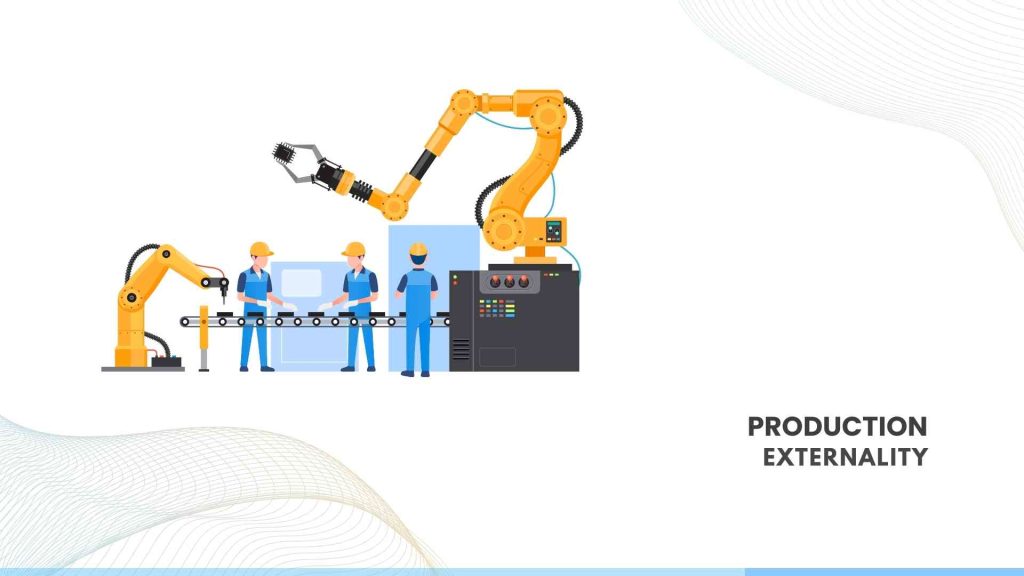Production externalities are a critical aspect of economics, affecting industries, markets, and societies in various ways. These externalities occur when producing a good or service has unintended positive or negative effects on 3rd parties not directly involved in the production process. We will explore the concept of production externalities, understand how they are measured, and provide examples highlighting their significance in the real world.
Definition of Production Externality
A production externality, also known as a supply-side externality, arises when a firm’s production process affects individuals or entities outside the firm’s immediate production and market activities. These effects can be beneficial or detrimental and are typically not considered when firms make their production decisions.
There are two primary types of production externalities:
Positive Production Externality: Occurs when producing a good or service benefits third parties not directly involved. For example, a beekeeper’s honey production may lead to increased pollination of neighboring farms, benefitting farmers and the ecosystem as a whole.
Negative Production Externality: Conversely, negative production externalities arise when the production process imposes costs on third parties. A classic example is pollution generated by a factory, which can harm the health of nearby residents and the environment.
Measuring Production Externalities
Economists and policymakers employ various measurement techniques to understand the economic impact of production externalities. Some common methods include:
Cost-Benefit Analysis (CBA): CBA is a systematic approach used to weigh the costs and benefits of a particular project, policy, or activity, including externalities. By assigning monetary values to the effects of production, CBA can help decision-makers assess whether the benefits outweigh the costs.
Social Cost Analysis: This approach calculates the total cost of production, including external costs, such as pollution, health issues, or resource depletion. It aims to determine the true social cost of production, considering both private and external costs.
Shadow Pricing: Economists often employ shadow pricing to estimate the value of externalities by assigning monetary values to non-market goods or services. This approach can deliver a more precise picture of the hidden costs and benefits associated with production.
Examples of Production Externalities
Let’s delve into some real-world examples of production externalities to illustrate their importance:
Positive Production Externality: Vaccination Programs
Vaccination programs provide a classic example of positive production externalities. When a significant portion of the people is vaccinated against a contagious disease, it benefits those individuals. It contributes to herd immunity, protecting those who cannot be vaccinated, such as infants or individuals with compromised immune systems.
Negative Production Externality: Air Pollution from Factories
Factories that emit pollutants into the air create negative production externalities. The health effects, environmental damage, associated healthcare costs, and clean-up are externalized to the community living near the factory. These external costs can be substantial and have long-term consequences.
Positive Production Externality: Education
Investments in education have positive production externalities. A well-educated workforce contributes to economic growth, innovation, and societal advancement. These benefits extend beyond the individuals and are enjoyed by society. Production externalities are an essential economic concept in shaping public policies and business decisions.
Understanding the different types of production externalities, how to measure their impact, and recognizing examples of their effects on society. And can help us make informed choices that consider the broader implications of our actions. Addressing positive or negative externalities is key to creating a more efficient and sustainable economy.
How Can Acumatica Enhance?
Acumatica Cloud ERP is a powerful solution to address and enhance the management of production externalities within the manufacturing industry. Acumatica empowers businesses to make informed decisions that optimize operations. And mitigate adverse externalities by providing comprehensive insights into resource allocation, supply chain dynamics, and environmental impacts.
This system’s real-time data visibility and robust analytics tools enable companies to proactively manage and reduce waste, energy consumption, and emissions. And other environmental and social footprints associated with production. With Acumatica ERP, manufacturers can achieve a more sustainable and responsible approach to production, meeting regulatory requirements and consumer expectations while improving operational efficiency and competitiveness.
Acumatica ERP offers a pathway to address and enhance production externalities for a brighter, more environmentally friendly future in the world. And increasingly focused on sustainability and responsible production. Feel free to reach out to us.

Vijay comes with a vast experience in ERP and enterprise solutions space with about 20 years of experience in various packaged application like Acumatica, SAP, Orion, Salesforce.com, SugarCRM and, SalesLogix.

